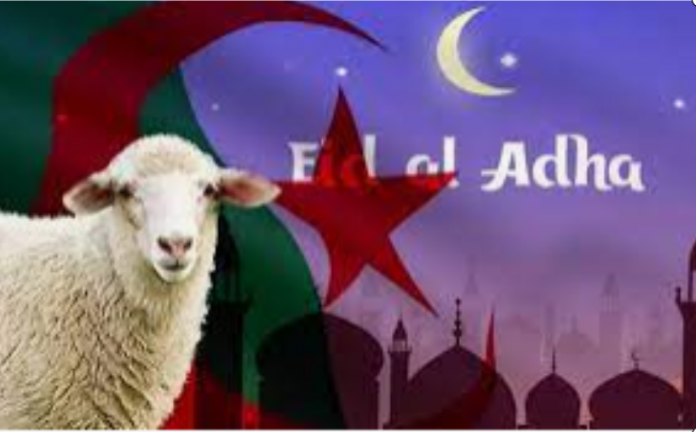ALGIERS- Eid al-Adha (Festival of Sacrifice) or Eid el Kebir (Greater Eid) is an important Islamic religious festival that is observed by Muslims world-wide. This is one of the two Eid festivals that are celebrated by Muslims, namely; Eid ul-Fitr that marks the end of Ramadan as well as Eid ul Kbir ( Eid Al Adha).
Eid al-Adha is a commemoration of the willingness of Ibrahim (Abraham) to sacrifice his son Ishmael for Allah. As Ibrahim was about to sacrifice Ishmael, Allah directed him to sacrifice a ram instead.
This festival starts on the 10th day of the lunar Islamic calendar month of Dhul Hijja. While Eid al-Adha is always on the same Islamic calendar date, the date on the Gregorian calendar varies each year. This is because the Islamic calendar is lunar and about ten days shorter than the Gregorian solar calendar.
The beginning of Eid al-Adha is the day after the Muslim pilgrims descend from Mount Arafat at the end of Hajj. As the fifth pillar of Islam, Hajj is a pilgrimage to Mecca in Saudi Arabia, an obligation that every able-bodied Muslim who can afford to do so must fulfill.
There are a number of traditions and practices related to Eid al-Adha; Algerian people, who refer to Eid al-Adha as the “Great Eid,” start holiday preparations many days before the holiday. One week before the feast, farmers put their sacrificial animals up for sale. People buy new clothes, accessories for themselves, their families as well as their religious brothers who are poor and less fortunate. Besides, they prepare sweets to please children.
Religious practice that includes the Sunnah to fast on the first nine days of Dhul-Hijjah, especially the Day of Arafat, is common because fasting is one of the best of deeds. In a hadith qudsi, Allah says: “All the deeds of the son of Adam are for him, except fasting, which is for Me and I shall reward for it.”
The Prophet said: “Fasting the day of `Arafah expiates the sins of two years: the past one and the coming one.”
For women, however, the preparations are not strictly religious; setting up the house to receive guests during Eid – a tradition for decades – is a must. Before Eid, women take the responsibility of cleaning the house. Some women go to the extreme of totally making over the whole house; refurbishing and painting. Algerian women usually buy new cooking utensils, which will be used in cooking the heavy meals and big banquets, and purchase new dishes.
Solidarity actions are organized in Algeria for Eid. The old tradition, “Waziaa” (sharing), perpetuated each year, reappears in the rural areas. This practice consists of the collective purchase of sheeps intended for the less fortunate people.
On the eve of Eid, families apply henna to the two horns of the sacrificial animal or its forehead, believing that it would be a “good omen.” Girls also get their hands’ palms decorated with traditional henna designs.

On the day of Eid, a Muslim is recommended by the Sunnah to have a shower before going to the Eid Prayer and wear the best of his or her clothes. This reflects Islam’s care for cleanliness and beauty. A Muslim should be careful regarding his or her appearance, dress, and personal hygiene.
For clothes, some would wear clothes from their culture, while others would pick out something new to wear.

To celebrate Eid al-Adha, Muslims in Algeria go to a mosque, prayer ground, or prayer court to offer special prayers and hear a sermon. In addition, Muslims are recommended to engage in public takbir (saying Allahu Akbar) in the masjids, market-places, streets, etc. This ibadah (act of worship) connects Muslims spiritually and spreads mercy, peace of mind, tranquility, and happiness. After the prayer, Algerians exchange greetings. The most popular greetings in Algeria are Eid mubarak (Blessed Eid) or Eid sa’id (Happy Eid) and Saha Eidkim.
Later at home, Algerians feast on the meat of livestock animals that have been sacrificed. Muslims sacrifice a sheep in commemoration of Ibrahim’s sacrifice. This is symbolic of a Muslim’s willingness to make sacrifices in order to continue pleasing Allah. As the sacrifice is being made, participants recite the name of Allah along with an offering statement and supplication as a reminder that all life is sacred.
The desirable division of the udhiyyah into three thirds—one third for the family, another for relatives, and a third for the poor—is another brilliant example that shows how far the Adha day implants love and care in the Muslims’ hearts for family, relatives, and for the whole society.
The entrails are offered, in turn, to a family who will transform them into “Kedid”. This latter is prepared by cutting the innards into small pieces mixing them with spices and a lot of salt, and drying them in the sun for a week or more, before keeping it in a suitable place to get consumed in winter with the Algerian popular dishes, such as; “Berkoukes”.
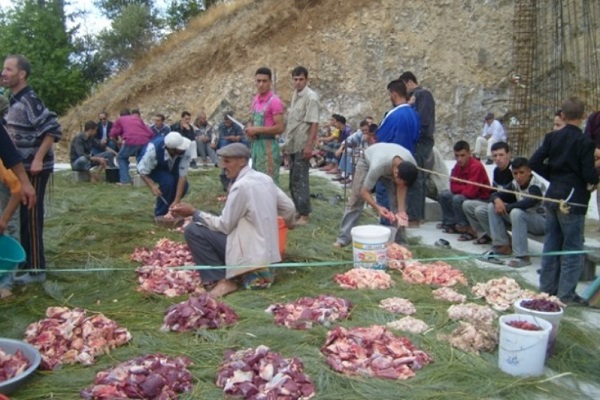
The rest of the meat is cooked and enjoyed with family and friends to strengthen the bonds within this group.There are many Algerian Eid Al Adha Specials, to wit; Osban (which is the stomach of the sheep), Bouzalouf ( the head) and meat and (Batata Koucha).
Al-Adha Day: A Model for Sharing and Caring
`Eid Al-Adha has unique spiritual, devotional, educational, and social meanings. It implants in the Muslim’s heart the spirit of sharing and caring. Muslims in Algeria, and all over the world, consider Eid Al Adha as a time of worship, to participate in charitable acts as well as strengthen ties with family and friends. The Eid day should not pass in Algeria without visiting to share traditional meals from our culinary wealth, calling, or e-mailing one’s relatives and family members in order to exchange Eid greetings and cement family ties.
The Algerian culinary art has its own specificities, diversity and richness. So to welcome the Eid festival, which combines sharing, spirituality, charity, sweet foods and traditional dishes, Algerian families prepare traditional recipes. Adding to this, the beautiful setting of the tables with varieties of traditional cakes from our rich culinary heritage.
All families present a variety of traditional dishes: couscous, chakhchoukha, rechta, trida, rougag, bouicha… The preparation of sweets is also on the agenda (dziriyette, mchawek, baklaoua, tcharak, galway tabaa, knidlette… .)

Here are some Eid al adha recipes
1- Bakbouka (mutton tripe in sauce) and how to clean the sheep’s stomach?

Ingredients:
Douara
Lungs
Liver
Heart
1 handful chickpeas
1 head garlic
3 dry chillies
Caraway, paprika, cinnamon
Salt and pepper
3 tbsp of oil
1 handful of rice
Method:
Clean the douara or the stomach:
Wash it in cold water.
Cut into 4 or 5 pieces with scissors.
Dip each piece (one at a time) in boiling water, remove promptly and using a knife scrape off the black cover up until the appearance of white flesh.
Wash and drain.
Cut into small pieces.
Wash the lungs, put them in boiling water for 20 minutes, remove and drain. Cut into small pieces with scissors.
Wash the liver and heart and cut into small cubes.
In a pan, put the Douara, lungs, liver and heart cut into small pieces.
Add garlic, dried chilli, spices and oil and sauté a few minutes.
Cover with water, add the chickpeas and cook.
At the end, add a handful of rice and cook.
Serve with coriander and parsley.


2- Mutton Feet in sauce and how to clean the bouzalouf?
Here is another dish that we find on the Algerian tables the day of Eid el Adha (Eid Lakbir).

Ingredients:
Sheep feet
1 head garlic
Red pepper, cumin
Salt and pepper
Hot pepper (optional)
1 handful chickpeas
3 tbsp of oil
1 bunch of parsley
Method:
How to Clean the bouzelouf:
Even if you buy the feet ready for your butcher, it is still necessary to clean them more. For me I have used my blowtorch to remove any remaining hair.
Wash them very well by rubbing with a cloth.
Prick with a knife, the part between the foot and the shoe and remove it.
Remove the 2 bumps on each foot.
Wash thoroughly in cold water.
Boil the feet until the meat comes off the bone. Do not discard the cooking water.
Cut each leg in half lengthwise and remove the meat from the large bone.
In a pot put the feet, add garlic and spices.
Add the oil and sauté.
Add 1 / 2 litre of water, and 2 ladles of the cooking water from the feet, chickpeas and leave to cook until the legs are cooked through.
Cook until the sauce reduces.


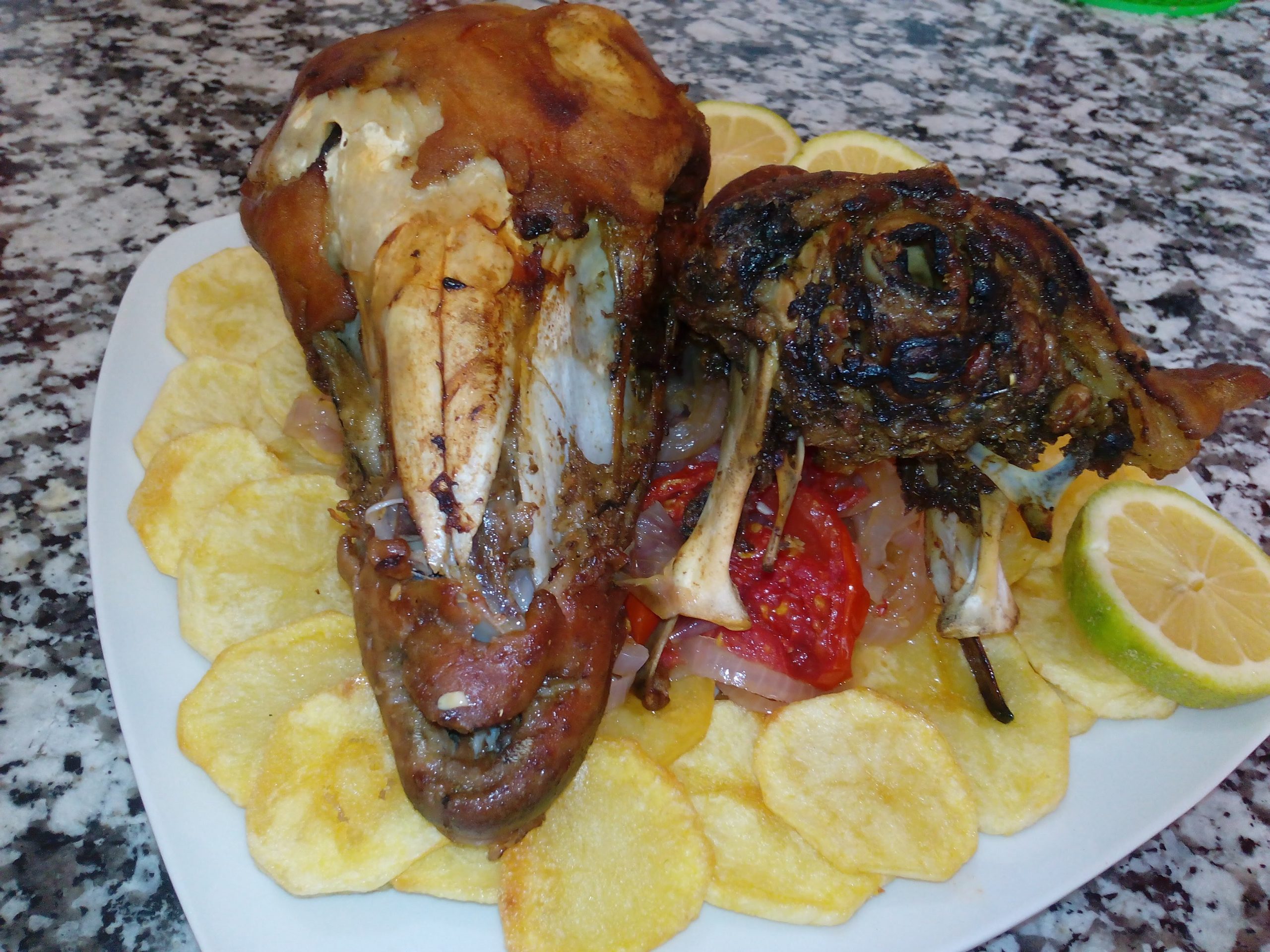
3- Osbane or stuffed Douwara
Osbane, the Algerian version of the Scottish Haggis

Ingredients:
For the osbane:
Douara or stomach already prepared
The same quantity of: Lungs already boiled, meat, liver, intestines and fat diced
1 handful chickpeas
1 tbsp of rice
1 onion
2 garlic cloves
Caraway, paprika, cinnamon
Salt, pepper
1 bunch cilantro
1 bunch parsley
For the sauce:
3 onions, finely chopped dried
1 tbsp of tomato concentrates
1handfull of chickpeas
Cumin, red pepper
Salt and pepper
3 tbsp of oil
1 bunch of parsley
Method:
Prepare the stomack and lungs (see recipe bakbouka).
Cut the stomach into 4 or 5 large pieces (depending on the size of it) so that each piece folded in half will form a pocket.
Using a needle and cotton, sew the pocket allowing a small opening to put the stuffing.
In a bowl, combine all ingredients.
Fill the pockets with the stuffing.
Sew the opening.
Prick several times.
This osbane can be cooked in boiling water or in a sauce.
In a pot, place all ingredients for sauce and osbanes.
Cover with water and cook (2 to 3 hours depending on the size).
The sauce should be reduced.


4- Mutton or lamb meat in sauce
Algerian Recipe for Tagine of meat with chickpeas

It is very easy and tasty recipe
Ingredients:
500g Mutton cut into small pieces
1 garlic clove
1 handful chickpeas
Paprika, cumin, cinnamon
Salt and pepper
3 tbsp of oil
Method:
In a tagine or pot, brown the meat in oil. Add crushed garlic and spices.
Cover with water, add the chickpeas and cook until the meat is cooked.
The sauce should be reduced.


5- Chtitha Mokh
Sheep’s Brain in Sauce with eggs and tomatoes

Ingredients:
200gr of brain (I didn’t count the number of brains)
2 heads of garlic
4 fresh tomatoes
Cumin, paprika
Salt and pepper
2 tbsp of oil
3 eggs
Parsley
Method:
Put the brains in water with vinegar for 1 / 2 hours, then plunge them into boiling water.
Remove from the water and remove the membrane covering them.
In a saucepan, sauté garlic, tomatoes and the spices with the oil.
Let to cook
Before the end of cooking add the brain and cook for 10 minutes.
Beat the eggs and add to the brain. Cook for 2 minutes.
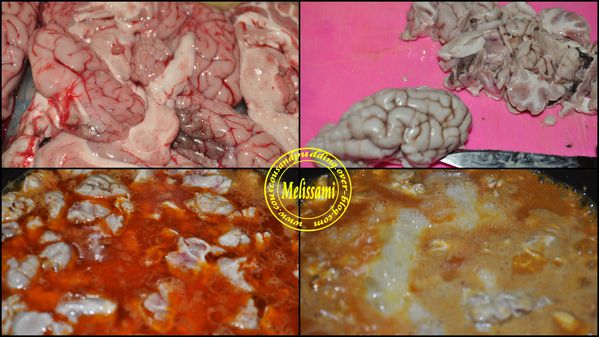
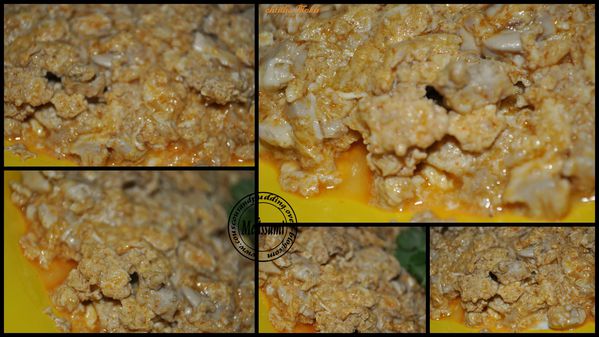
6- Lamb Liver in Sauce, Kebda Mchermla

Ingredients:
1 lamb liver (lamb for me)
1 / 2 lamb heart
4 garlic grouse
1 tsp caraway
1 tsp red pepper
Salt, black pepper
1 teaspoon vinegar
Method:
Mix the crushed garlic with the spices and a little water.
Fry this mixture in 4 tbsp of oil.
Cut the liver into small pieces.
Put the pieces of liver in the sauce and cook over low heat.
Drizzle with vinegar and remove from heat immediately.
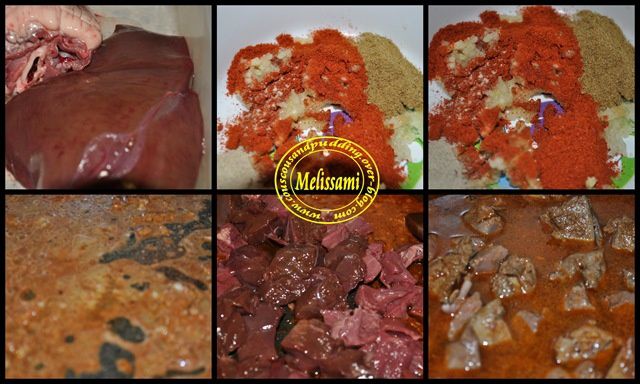

Photos of Eid celebrations in Algeria in 70s-80s





Aïd El Adha in Algeria in the 1930s…
Interviewed by Algerie-focus, the Chaouia Fatma, 86, dives back into her memories to revive these days of belief and communion. The smell of Eid floats for several days in Algeria. The country keeps breathing and living to the rhythm of the festival. “Each day had its precise ritual and was part of the Chaouia tradition which was perpetuated from generation to generation,” assures Fatma. The eve of Aid al Adha was as important as the religious festival itself in Batna and its surroundings. The family gathers and to bless this moment, everyone puts on henna, men and women. “It was said that the prophet applied henna himself,” adds Fatma. The moment of the rite of sacrifice was arguably the highlight of Eid al Adha. It is the most intense moment of sharing since all the families come together to slaughter their sheep and share the meat that is used to feed several families.
After having sacrificed the sheep, the inhabitants of Batna keep the bones of the animal (part of the pelvis) in order to predict the future. “Everyone brought back their bones, and sorts of seers read the future using them. According to the bone we had in hand we could predict whether the year would be fortunate or not. We relied on them to predict the field of harvest,” recalls Fatma.
Ancient beliefs in Algeria!

Many Algerians remain faithful to old traditions and beliefs of their ancestors, which are linked to celebrations of weddings, circumcision or religious holidays, such as; the feast of Eid el-Adha when a sheep is sacrificed. Here are the old beliefs of Algerians linked to Eid Al Adha:
* Henna on the head of sheep to ward off the evil eye:
While we were preparing this report in the neighborhoods of Algiers before the day of Eid, we met a group of youths, each holding a sheep decorated with henna on the head and different body parts. Fights are organized, draining a large crowd of onlookers, mostly children and teenagers.
To our question on the henna, the young “A. L.” replied, smiling: “As you can see, my sheep is very big and healthy, so I fear for him. He may be struck in an evil eye!”.
* For women only: The fleece of the sheep to smooth facial skin:
Wipe your face seven times with the inside of the fleece, the lady “B. Y.” an intellectual says. Before adding that it is very effective against acne!
* The bones of the lower jaw of the sheep against throat aches!
Haja Aisha from Boumerdes says she has always kept the lower jaw of the sheep to treat inflammation of the throat. The latter is applied hot on different part of the neck.
* Sheep’s blood to treat migraine and headaches!
In many parts of the province of El Bayedh, the day of sacrifice, the father slaughters the sheep and keeps a little of his blood that is used to treat migraine headaches, while the tail of sheep is hung on the wall to ward off the evil eye.
In southern Algeria, the tail of sheep is immediately hooked, after slaughter, on a palm tree to ward off bad luck, according to the beliefs of the inhabitants.
In short, Eid Al-Adha in Algeria, like all Muslim countries, is an occasion to maintain love, care, brotherhood, beauty, and solidarity. Eid has significant social, educational, devotional, and spiritual messages that Muslims should grasp and translate into a complete way of life.
Algeria+ Algerian cuisine

















